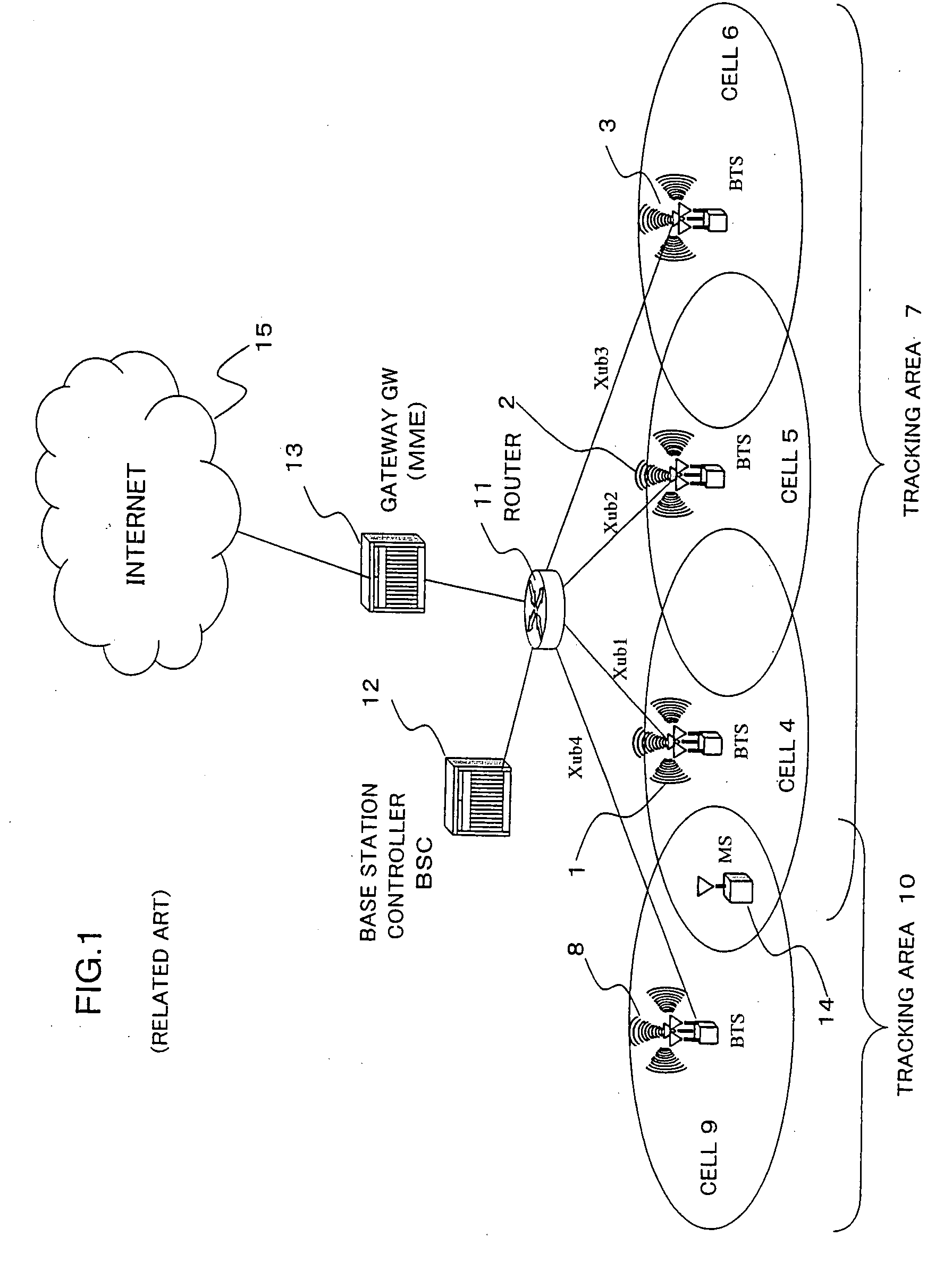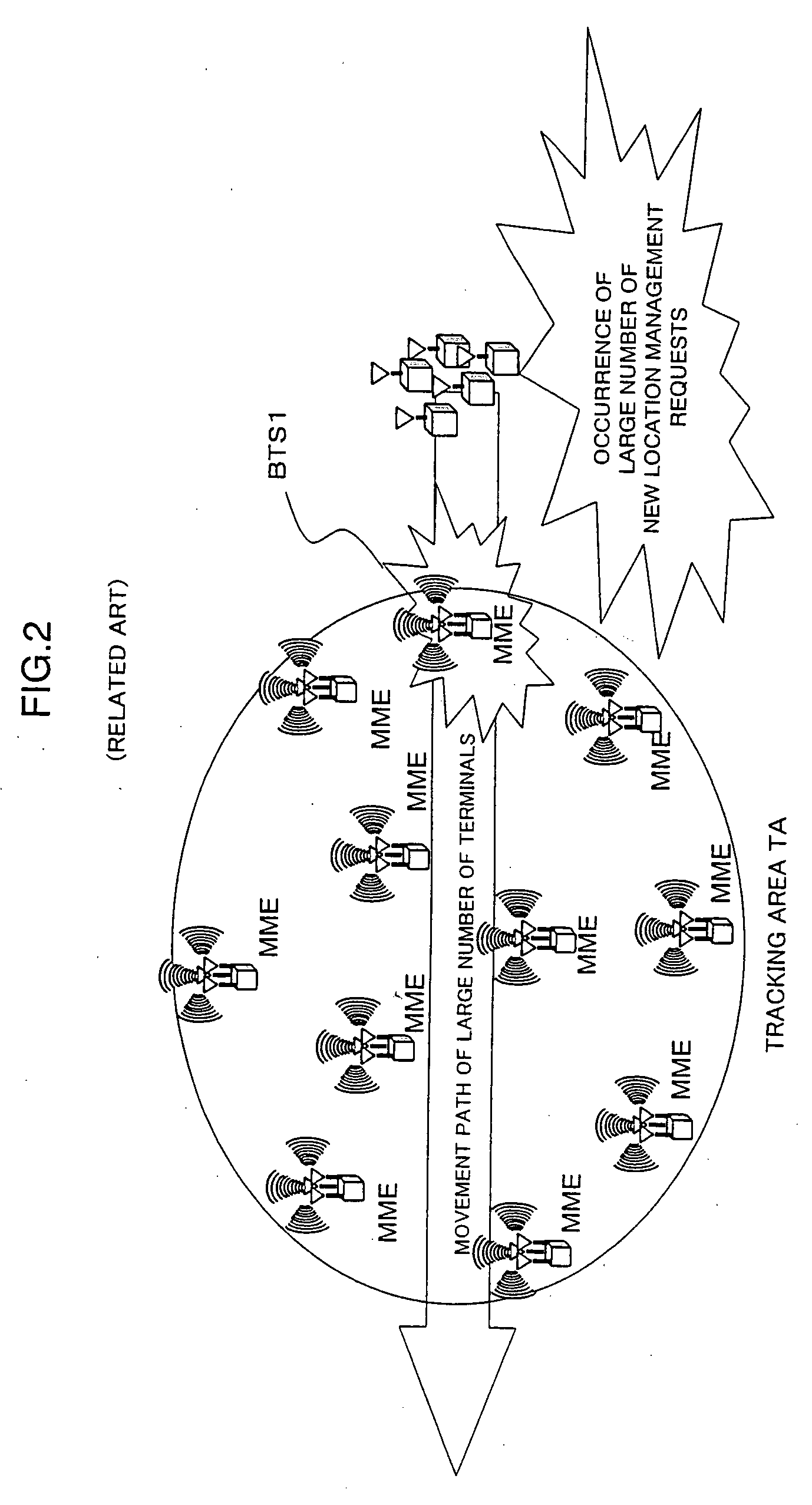Mobility management control technique and mobile communications system
a technology of mobility management and control technique, applied in the field of mobile communications system, can solve the problems of uneven load of mobility management processing among the base stations, depletion of temporary identities (unique numbers), and depletion of temporary identities, so as to reduce uneven use rate of communication lines, maximize network capacity for each area, and reduce the difference in load between them
- Summary
- Abstract
- Description
- Claims
- Application Information
AI Technical Summary
Benefits of technology
Problems solved by technology
Method used
Image
Examples
first embodiment
[0118]FIG. 11 is a sequence diagram showing a mobility management control method according to a first embodiment of the present invention. FIG. 12 schematically shows pieces of information contained in signals used in this sequence. According to the first embodiment, a base station serving as a serving base station which has fallen in a high-load state relocates a mobility management context MMC for a mobile station to a neighboring base station with a reduced load if there is such a reduced-load base station among the neighboring base stations, thereby relocating the location management as a serving base station to this neighboring base station.
[0119]First, a mobile station 23 is initialized, for example, when powered on in a tracking area (time T1). Then, it is assumed that, based on a broadcast signal received from a base station 24 producing the best reception sensitivity, the mobile station 23 confirms that the tracking area is different from the tracking area that has been loc...
second embodiment
[0125]FIG. 13 is a sequence diagram showing a mobility management control method according to a second embodiment of the present invention. FIG. 14 schematically shows pieces of information contained in signals used in this sequence. According to the second embodiment, if a new area update request occurs when a base station is in a high-load state, the update processing is allocated to a neighboring base station with a reduced load.
[0126]Base stations 24 to 26 are mutually selected neighboring base stations and are assumed to exchange MMLI with each other as described above. It is assumed that the load on the base station 26 has first fallen to or below the low-load notification threshold value LLR_T, and then the load on the base station 25 has also fallen to or below the low-load notification threshold value LLR_T, due to the fact that, for example, a plurality of mobile stations under their respective managements have moved to other tracking areas, or the like. In this case, as d...
third embodiment
[0131]FIG. 15 is a sequence diagram showing a mobility management method according to a third embodiment of the present invention. In the third embodiment, it is assumed that, through the sequence of the second embodiment shown in FIG. 13, the base station 25 has become the MMSBTS of the mobile station 23, and that the mobile station 23 has moved around in the same tracking area and is currently present in the cell of the base station 26.
[0132]In this state, when a data packet destined for the mobile station 23 arrives at the gateway 20, the gateway 20 sends a location search request for searching for the location of the mobile station 23 to the base station 25, which is the MMSBTS of the mobile station 23 (time T1). In response to this, the serving base station 25 inquires of all the base stations in the tracking area TA, where the mobile station 23 is located (time T2). Since the mobile station 23 is currently located in the cell of the base station 26 in this case (times T3 and T...
PUM
 Login to View More
Login to View More Abstract
Description
Claims
Application Information
 Login to View More
Login to View More - R&D
- Intellectual Property
- Life Sciences
- Materials
- Tech Scout
- Unparalleled Data Quality
- Higher Quality Content
- 60% Fewer Hallucinations
Browse by: Latest US Patents, China's latest patents, Technical Efficacy Thesaurus, Application Domain, Technology Topic, Popular Technical Reports.
© 2025 PatSnap. All rights reserved.Legal|Privacy policy|Modern Slavery Act Transparency Statement|Sitemap|About US| Contact US: help@patsnap.com



